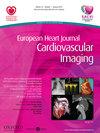Spontaneous coronary artery dissection: the role of Coronary CT angiography in the follow-up management
引用次数: 0
Abstract
Abstract Funding Acknowledgements Type of funding sources: None. Background Spontaneous coronary artery dissection (SCAD) is one of the causes of acute coronary syndrome (ACS), myocardial infarction (MI) and sudden death (SD). Diagnosis is done with coronary angiography (CA); nevertheless, coronary computed tomography angiography (CCTA) is a new useful tool in the acute diagnosis and at follow-up. Treatment could involve a conservative approach or an invasive approach with percutaneous coronary intervention (PCI) or coronary artery bypass grafting (CABG). Purpose 1) analyze the clinical and CCTA features at baseline of patients with a SCAD diagnosis; 2) evaluate the clinical and anatomic outcome at follow-up of patients with a SCAD diagnosis treated with a conservative or invasive approach; 3) evaluate in the conservative approach treated patients the clinical and anatomic outcome of those dismissed with single or double antiplatelet therapy. Methods A retrospective analysis of 57 patients affected by SCAD followed up with Coronary CT angiography (CCTA) between 2010 and 2022. Clinical and anatomic data were collected at baseline and at the follow-up (FU). The clinical endpoints evaluated were: all cause mortality, hospitalization for cardiovascular cause, SCAD or PCI ex-novo and MI; the anatomic endpoints were: patency of coronary artery and/or stents and length dissection changing from baseline. Results 57 patients were divided in 2 groups: 46 (80,7%) patients underwent a conservative treatment and 11 (19,3%) patients a PCI treatment. Patients treated with PCI has a significative incidence of smokers (45,5% vs 15,2%; p = 0,042), peripherical arteriopathy (18,2% vs 0%; p = 0,034), higher troponin peak (40425,8 vs 13436; p = 0,011) and lower ejection fraction (51,4±11,0 vs 57,1±7,6; p = 0,050). Moreover the PCI population has a significant involvement of more than one coronary artery (72,7% vs 6,5%; p<0,001), of the proximal tracts of the coronary arteries (22,8% vs 13 %; p = 0,001) and of the truncus communis (45,4% vs 0%; p<0,001). At the follow up, there were no statistical differences for the clinical and anatomic endpoints between the conservative and invasive treated patients (p>0,05). Among patients treated with conservative therapy, there were a significant recurrence of SCAD in those treated with DAPT than in those treated with SAPT (33,3% vs 5,9%; p = 0,033). Conclusions patients with SCAD managed with PCI have more cardiovascular risk factors, a major myocardial infarction extension and a more complex coronary arteries involvement; conservative management is comparable to the PCI treatment for the clinical and anatomic endpoints evaluated; DAPT at discharge was associated with a higher rate of SCAD recurrence at follow-up.自发性冠状动脉夹层:冠状动脉CT血管造影在后续治疗中的作用
资金来源类型:无。背景:自发性冠状动脉夹层(SCAD)是急性冠状动脉综合征(ACS)、心肌梗死(MI)和猝死(SD)的病因之一。诊断通过冠状动脉造影(CA)完成;然而,冠状动脉计算机断层血管造影(CCTA)在急性诊断和随访中是一种新的有用工具。治疗可包括保守入路或经皮冠状动脉介入治疗(PCI)或冠状动脉旁路移植术(CABG)。目的1)分析SCAD诊断患者的临床和CCTA基线特征;2)评价经保守或有创入路治疗的SCAD患者的临床和解剖随访结果;3)评价保守方法治疗的患者在接受单次或双次抗血小板治疗后的临床和解剖结果。方法回顾性分析2010 ~ 2022年57例SCAD患者行冠状动脉CT血管造影(CCTA)的临床资料。在基线和随访(FU)时收集临床和解剖数据。评估的临床终点为:全因死亡率、心血管原因住院、SCAD或PCI复发和心肌梗死;解剖终点为:冠状动脉和/或支架的通畅和长度剥离从基线变化。结果57例患者分为两组:46例(86.7%)行保守治疗,11例(19.3%)行PCI治疗。接受PCI治疗的患者吸烟者的发生率显著(45.5% vs 15.2%;P = 0,042),外周动脉病变(18.2% vs 0%;P = 0.034),肌钙蛋白峰值较高(40425,8 vs 13436;P = 0.011)和较低的射血分数(51,4±11,0 vs 57,1±7,6;P = 0.050)。此外,PCI患者明显累及不止一条冠状动脉(72.7% vs 6.5%;P< 001),冠状动脉近端束(22.8% vs 13%;P = 0.001)和树干的比例(45.4% vs 0%;p&肝移植;0001)。随访时,保守治疗与有创治疗患者的临床和解剖终点无统计学差异(p> 0.05)。在接受保守治疗的患者中,DAPT治疗组的SCAD复发率明显高于SAPT治疗组(33.3% vs 5.9%;P = 0.033)。结论经PCI治疗的SCAD患者有更多心血管危险因素,主要心肌梗死扩展,冠状动脉受累更复杂;保守治疗的临床和解剖终点评估与PCI治疗相当;出院时的DAPT与随访时较高的SCAD复发率相关。
本文章由计算机程序翻译,如有差异,请以英文原文为准。
求助全文
约1分钟内获得全文
求助全文

 求助内容:
求助内容: 应助结果提醒方式:
应助结果提醒方式:


